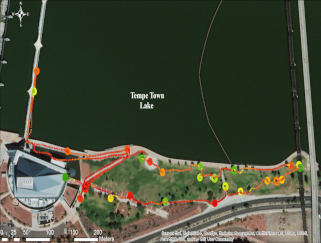Microclimate Variability in a Desert Urban Park
Authors
- Middel A – Arizona State University
- McWest L – Arizona State University
- Melzter S – Arizona State University
- Vanos JK – Arizona State University
- Hondula DM – Arizona State University
Purpose
Evaluate microclimate variability in a desert urban park using a mobile mean radiant temperature sensing station (MaRTy).
Description
Blue and green infrastructure can cool down urban temperatures and increase thermal comfort through the conversion of solar energy into latent heat. These data were collected to measure microclimate variability at Rio Salado Park in Tempe, Arizona, with an emphasis on the impacts of trees and water bodies on human thermal comfort and mean radiant temperature during hot summer conditions. Researchers conducted five 90-minute transects at two hour intervals on a clear-sky, hot summer day, through Rio Salado Park using mobile biometeorological cart, MaRTy. Measurements include time-detrended temperature and relative humidity, wind speed and direction, GPS derived location, direction-specific short and long wave radiation. Physiological Equivalent Temperature was derived from the observations using RayMan software.
Attributes
2-second observations/calculations of air temperature, relative humidity, wind speed, wind direction, longitude, latitude, elevation, 6-directional shortwave radiation, 6-directional longwave radiation, and Physiological Equivalent Temperature. Measurements were collected along a specified route through Rio Salado Park with designated stop locations for additional sampling.

